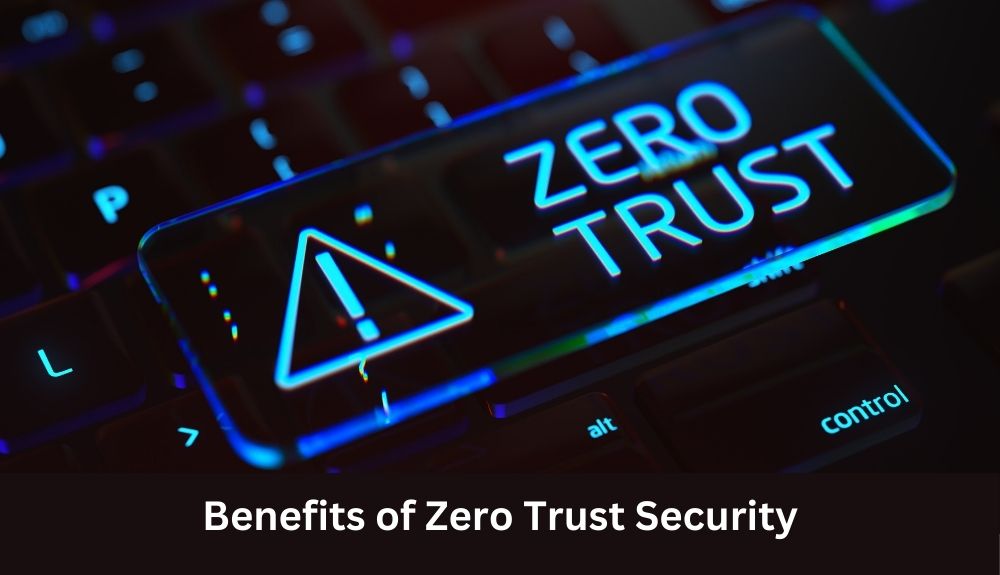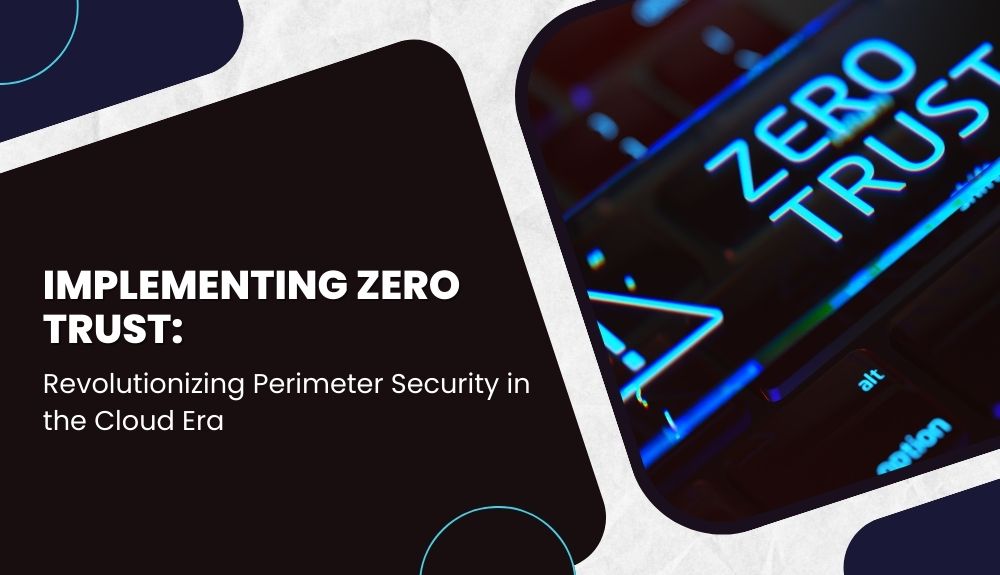Are you still relying on outdated perimeter security measures to protect your data in the ever-evolving cloud era? Imagine a security approach where trust is never assumed, access is continuously monitored, and sensitive data remains protected from potential threats at all times. This is where the concept of Zero Trust Security comes into play, revolutionizing the way organizations safeguard their digital assets.
🔒 In this blog, we dive deep into the world of Zero Trust Security, exploring its principles, benefits, and best practices for implementation in a cloud-driven environment. Say goodbye to the traditional security model that solely focuses on network perimeters and embraces a data-centric approach that prioritizes secure access and data protection.
🌐 Uncover real-world examples and use cases of Zero Trust Security in action, understand the fundamental shift from implicit trust to strict access control, and discover how this paradigm shift is reshaping cybersecurity strategies globally. Join us on this insightful journey as we unveil the power of Zero Trust in safeguarding against cyber threats in the digital age.
Introduction to Zero Trust Security Model
The Zero Trust Security Model is a revolutionary approach to perimeter security in the cloud era. Traditionally, organizations relied on perimeter-based security measures to protect their networks and data. However, with the increasing complexity and sophistication of cyber threats, this approach has become outdated and ineffective.
The Zero Trust Security Model shifts the focus from perimeter-based security to a data-centric approach. It operates on the principle that no user or device should be trusted by default, regardless of their location within the network. Instead, every request for access is thoroughly verified and authenticated, ensuring that only authorized entities can gain entry.
This model redefines the traditional notion of perimeter-based security by eliminating implicit trust and implementing rigorous access controls at every level of the network. It emphasizes the principle of least privilege, granting users only the necessary permissions to perform their tasks.
By adopting the Zero Trust Security Model, organizations can minimize the risk of lateral movement of threats and reduce their attack surface. This is especially crucial in the ever-changing digital environment of today, where legacy technology and traditional security mindsets are no longer sufficient.
In the next sections, we will explore the key principles, benefits, and implementation strategies of the Zero Trust Security Model, providing you with the knowledge and guidance to enhance your organization’s security posture in the cloud-driven world.
Understanding the Problem Statements
In today’s fast-paced digital landscape, traditional perimeter-based security models are facing several limitations and challenges. These models, which rely on the assumption that everything inside the network perimeter can be trusted, are no longer effective in protecting sensitive data and mitigating cyber threats. Here are some key problem statements associated with the traditional security approach:
Legacy Technology Vulnerabilities
Legacy technologies often lack the necessary security features to defend against sophisticated and evolving cyber attacks. Outdated firewalls and intrusion detection systems struggle to keep up with the increasing complexity of threats, leaving organizations vulnerable to breaches.
Lateral Movement of Threats
Once inside the network perimeter, attackers can move laterally between systems, exploiting unsecured connections and weak access controls. This lateral movement makes it difficult to contain and mitigate the impact of an attack, as threats can spread undetected across the network.
Limited Visibility and Control
Traditional security models typically focus on securing the network perimeter, leaving blind spots within the internal network. Organizations often lack real-time visibility into user activities, leading to delayed detection and response times for potential breaches.
Ineffective Access Control
Perimeter-based security relies on implicit trust, granting users broad access privileges once they are inside the network. This “trust but verify” approach can lead to excessive privileges and increase the risk of a data breach. Furthermore, it does not adequately protect against insider threats or compromised user accounts.
Remote Work and Cloud Adoption
The rise of remote work and cloud technologies has expanded the attack surface of organizations. Traditional perimeter-based security struggles to secure remote access and protect data in cloud environments, where data is dispersed across multiple locations and accessed from various devices.
To address these problem statements and stay ahead of the ever-changing threat landscape, organizations are increasingly adopting the Zero Trust Security Model. This paradigm shift in security thinking focuses on a data-centric approach and strict access controls, minimizing the risk of data breaches and providing better overall protection in the cloud-driven world.
By understanding the limitations of traditional security models, organizations can recognize the importance of implementing a Zero Trust Security Model and take proactive steps towards securing their data and networks.
Key Principles of Zero Trust Security

The Zero Trust Security Model is built upon a set of core principles that fundamentally challenge the traditional notion of perimeter-based security. By adopting these principles, organizations can establish a robust and resilient security framework that aligns with the ever-changing digital environment of today.
Principle of Least Privilege
One of the key principles of Zero Trust Security is the principle of least privilege. This principle emphasizes the need for strict access control, ensuring that each user or entity is granted only the minimal privileges necessary to perform their specific tasks. By minimizing unnecessary access and permissions, organizations can effectively limit the potential damage caused by compromised accounts or malicious insiders.
Continuous Monitoring
Continuous monitoring is another crucial principle of Zero Trust Security. Rather than relying solely on static security measures, organizations need to implement real-time monitoring and analysis of network traffic, user behavior, and system activities. This proactive approach enables early detection and response to potential threats, reducing the risk of a data breach or cyber attack.
Data-Centric Security
In the Zero Trust Security Model, the focus shifts from securing the network perimeter to protecting the data itself. This data-centric approach recognizes that sensitive data resides not only in on-premises data centers but also in cloud environments and remote devices. By implementing strong encryption, data loss prevention mechanisms, and secure access controls, organizations can ensure the confidentiality, integrity, and availability of their critical information.
Zero Trust Architecture
A key enabler of Zero Trust Security is the adoption of a Zero Trust Architecture. This architectural approach favors the abandonment of implicit trust and includes technologies like Zero Trust Network Access (ZTNA) and multi-factor authentication. By implementing a Zero Trust Architecture, organizations can effectively address the boundaries of the traditional network perimeter, reduce the attack surface, and enable secure access for both internal and external users.
By adhering to these core principles, organizations can lay the foundation for a Zero Trust Security Model that provides enhanced security in today’s data-driven world. The paradigm shift from a traditional security mindset to a Zero Trust approach is a crucial step in mitigating the ever-evolving cyber threats and safeguarding sensitive data from both external and internal risks.
Implementing Zero Trust Security
Implementing Zero Trust Security is a crucial step for organizations looking to enhance their cybersecurity strategy in the ever-changing digital environment of today. By shifting the focus from perimeter-based security to a data-centric approach, Zero Trust Security ensures that access to sensitive data is carefully controlled and monitored, regardless of the user’s location or network.
To start implementing Zero Trust Security, organizations should consider adopting a Zero Trust Architecture. This architecture eliminates the traditional notion of a network perimeter and instead focuses on strict access control and continuous monitoring. By favoring the principle of least privilege, organizations can minimize the risk of a data breach and reduce the network’s attack surface.
Key steps in implementing Zero Trust Security include:
1. Identifying sensitive data: Organizations must identify and classify their sensitive data to determine the level of protection required.
2. Implementing strict access controls: By implementing strong authentication mechanisms and multi-factor authentication, organizations can ensure that only authorized users have access to sensitive information.
3. Continuous monitoring: Organizations should implement real-time monitoring and logging to detect any potential threats or suspicious activity within their network.
4. Segmentation and micro-segmentation: Segmenting the network into smaller, isolated segments and applying strict access policies helps prevent lateral movement of threats.
5. Regular assessments and updates: Ongoing assessments and updates to security policies and technologies are crucial to maintaining a robust Zero Trust Security framework.
With careful planning and the adoption of a Zero Trust Architecture, organizations can successfully implement Zero Trust Security and significantly enhance their data security measures in today’s data-driven world.
Benefits of Zero Trust Security

Implementing a Zero Trust Security Model offers numerous benefits that are crucial in today’s ever-changing digital environment. By shifting the focus from perimeter-based security to a data-centric approach, organizations can enhance their overall security posture and better protect sensitive data. Here are some key advantages of implementing Zero Trust Security:
1. Improved Threat Detection: Zero Trust Security promotes continuous monitoring and analysis of network traffic, allowing organizations to detect and respond to potential threats more effectively. This proactive approach helps identify suspicious activities, anomalies, and potential cyber threats, enabling early mitigation and reducing the impact of attacks.
2. Reduced Attack Surface: Traditional security models often rely on implicit trust within the network perimeter, leaving potential vulnerabilities for attackers to exploit. With Zero Trust Security, access to resources and data is strictly controlled, reducing the attack surface and minimizing the potential impact of a data breach or cyber attack.
3. Enhanced Data Protection: Zero Trust Security puts a strong emphasis on data protection. By adopting a data-centric approach, organizations can implement strict access controls, encryption protocols, and data loss prevention measures. This ensures that sensitive data remains protected, even in the event of a breach.
4. Adaptive Access Control: Zero Trust Security provides granular access control, allowing organizations to implement the principle of least privilege. Users are granted only the necessary access required to perform their specific tasks, reducing the risk of unauthorized access and minimizing the potential for lateral movement of threats within the network.
5. Improved Compliance: As data protection regulations become more stringent, organizations need to demonstrate strong security measures. Implementing Zero Trust Security helps organizations meet compliance requirements by focusing on data protection, access controls, and continuous monitoring.
By embracing the benefits of Zero Trust Security, organizations can effectively mitigate cyber risks, protect sensitive data, and strengthen their overall security posture in the cloud-driven world.
Conclusion
In conclusion, the adoption of Zero Trust Security in the cloud-driven world is essential for organizations seeking to enhance their perimeter security. By shifting the focus from perimeter-based security to a data-centric approach, the Zero Trust Security Model ensures that sensitive data is protected regardless of its location or the network perimeter.
The key benefits of implementing Zero Trust Security include improved threat detection and reduced attack surface. This approach emphasizes the principle of least privilege, providing strict access control and continuous monitoring to prevent lateral movements of threats.
Successful implementation of Zero Trust Security requires careful planning and the adoption of a Zero Trust Architecture. By breaking away from the traditional notion of perimeter-based security, organizations can address the ever-changing digital environment and mitigate the risk of data breaches.
In this data-driven world, adopting a Zero Trust Security Model plays a crucial role in safeguarding corporate networks and mitigating potential threats. With the constant evolution of technology and the rise of cloud environments, organizations must embrace this paradigm shift and prioritize data-centric security for a secure and resilient future.
Remember, secure access and data protection should be the fundamental principles guiding your cybersecurity strategy in the ever-changing threat landscape.



